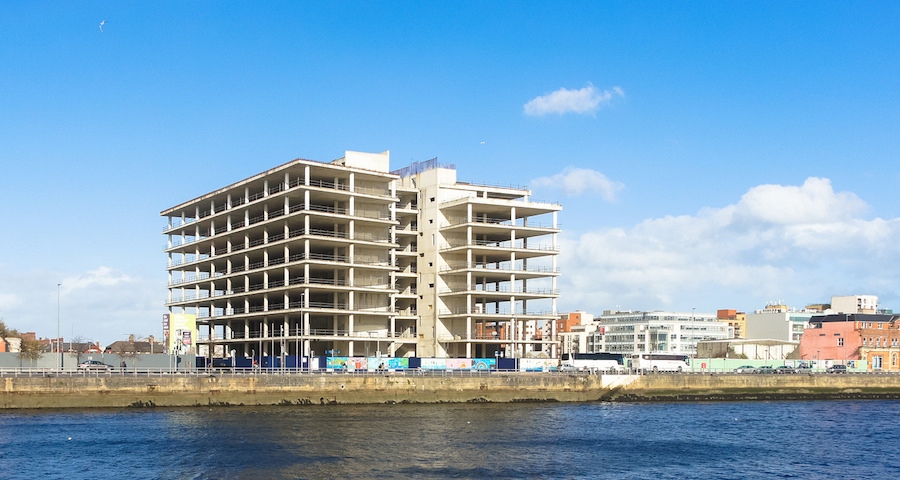
- Blogs
- Posted
Irish construction industry has long opposition to higher standards
This article, originally published in 2012, details the Irish building industry's history of opposition to higher standards.
In light of objections by the construction industry to plans by Dún Laoghaire Rathdown County Council to make the passive house standard mandatory in the area, we decided to republish this 2012 article from Village magazine by our deputy editor, Lenny Antonelli, which details the history of the industry’s objections to higher standards. This stretches from opposition in 1978 to requiring a very minimal standard of insulation to the industry’s current objections to passive house. A longer article on the same theme was published at the time in our predecessor magazine, Construct Ireland. References are included below the article.
First published in Village magazine, May 2012
The government has launched a public consultation on building control following the high profile evacuation of the Priory Hall development in north Dublin due to fire safety defects. But the proposed changes are nothing more than a paper exercise that will do little to boost the number of on site building inspections.
The new rules demand the submission of “certificates of compliance” confirming a project meets the legal requirements of the building regulations. Drawings showing how a building complies will also have to be lodged. But it speaks volumes that such basic measures aren’t already in place.
Following Priory Hall, environment minister Phil Hogan said the fact Dublin City Council took the case to court “is a clear indication the Building Control Act is robust” (1). But if the act was robust, 240 people wouldn’t have moved into a faulty building. And the government wouldn’t be fixing the act six months later.
Priory Hall highlighted the lack of on-site building inspection in Ireland. The government requires local authorities to inspect just 12-15% of buildings. In 2010 — the last year for which figures are available — the average local authority inspected just a quarter of buildings. Four local authorities failed to meet their target, and two — Wexford County and Waterford City Councils — inspected no buildings at all. (2)
But the Irish Home Builders Association — a division of the Construction Industry Federation (CIF) — defended Irish builders in the wake of Priory Hall, and said the system of self-certifying buildings had worked well. “Priory Hall is an exceptional case,” director Hubert Fitzpatrick told Construction, the CIF magazine last October. But is it really? (3)
None of the houses examined for a study of 52 homes built between 1997 and 2002 complied fully with building regulations. The study was commissioned by the Sustainable Energy Authority of Ireland but never published. Green building magazine Construct Ireland, which I’m deputy editor of, obtained it last year.
The study examined the homes for compliance with regulations on energy efficiency, ventilation and “heat producing appliances”. Just one complied with energy efficiency rules in full, almost half failed to meet the rules for heat producing appliances, and over 40% failed to minimum ventilation standards. (5)
In a 2005 study, the National Disability Authority found housing had a “poor level of compliance” with Part M of the building regulations, which deals with access for people with disability. These are the only two known studies that have looked at whether Irish housing complies with any parts of building regulations, according to the Department of Environment.
Other stories undermine the idea the Priory Hall is an exception. Up to 20,000 homes may now be infected with pyrite, a mineral that can cause some construction materials to expand and crack if exposed to air and water (7). Socialist TD Joe Higgins described these homes as “exploding in slow motion”.
Meanwhile in Balgaddy, West Dublin, up to 400 local authority houses built at the height of the boom are plagued by dampness, mold, cracking, leaks, and electrical and sewage faults. (8)
And earlier this year, it was reported that up to 300 homes and apartments at Balmayne, north Dublin require expensive repairs due to fire safety faults.(9) Though it’s little comfort to the people living in there, these cases are the natural outcome of decades of under-regulation, lack of enforcement and lobbying against better building standards.
Though the first draft was written in 1967, building regulations weren’t made law until more than 20 years later.(10)
As far back as 1978, Construction Industry Federation managing director Thomas Reynolds said making any insulation mandatory in new homes would be “entirely unrealistic and bureaucratic”. (11)
That same year, the Building Industry Council urged the Department of Environment to scrap its draft building regulations and re-write it “with a greater understanding of the impact such regulations will have on industry.” (12)
Then in 1982, the Irish Times reported that Aidan McDonald, a Department of Environment official, told the Stardust disaster tribunal that the building industry had lobbied against a system of building inspection and approval. The department accepted the industry’s arguments and decided to move towards self certification, the Times reported. (13)
Building regulations finally came into force in the early nineties, along with the self certification system that gave us Priory Hall.
In 1998, an internal Department of Environment memo acknowledged energy efficiency standards were inadequate and needed updating. “We don’t want to signal this to the outside world yet because the next leap in building standard insulation will probably involve making it difficult for ‘hollow block’ construction, used widely in Dublin, to survive,” the memo read. This was revealed in a freedom of information request to Century Homes founder Gerry McCaughey. (14)
But the department didn’t update the rules for another four years, during which hundreds of thousands of homes were built. Then in 2007, the Construction Industry Federation warned that plans to boost minimum energy efficiency standards by 40% would add €15,000 to the price of new homes. The price rise never materialised. (15)
The Irish Homes Builders Association objected to plans the same year by Dun Laoghaire – Rathdown County Council to introduce its own tough energy efficiency rules, arguing the target was unachievable. (16) But a similar standard is now in effect nationwide.
Insulating a house properly is about more than just it keeping warm. Over 300,000 households in Ireland experience energy poverty (17). Excess winter mortality — the surplus number of people that die in winter — in Ireland was found to be double that of Norway in a 2000 study by UCD researchers Peter Clinch and Jonathan Healy. Poor building standards could be one of the main causes, the authors said (18). Clinch and Healy also found that over half of elderly households in Ireland endured “inadequate” winter temperatures in a separate study that year. (19)
Countries with the highest winter mortality — Portugal, Spain, Ireland and UK — are also those with the poorest building standards, another study concluded the following year. (20)
The number of excess winter deaths has fallen since, and insulation standards have improved, but Ireland still experiences more excess winter deaths than the most of Europe, according to the Institute of Public Health. (21)
Upgrading and insulating our building stock could form the core of a green economic programme that would reduce fuel poverty, cut carbon emissions and save construction jobs. But the government has slashed home energy grants in successive budgets, even though SEAI research found every euro spent delivers a net benefit of €5 to society (22). The uptake of grants has plummeted this year.(23)
Yet in some ways Ireland is actually pushing the boundary of cutting edge, low energy construction. We built the first passive house — the leading standard of ultra low energy building — in the English speaking world, and we’ve become a world leader in this standard. But this is down to the ambition of our best architects, designers and builders, rather than government initiatives.
On paper, our minimum standards for energy efficiency are strong, but there’s little enforcement. At Construct Ireland, we frequently encounter buildings that fail to meet energy efficiency standards — either because the builder or architect doesn’t understand how to comply, or because they have little fear of inspection.
In 2009, a spokesperson for the Irish Homes Builders Association said the last government’s plan that all new homes be zero carbon by 2013 was “extremely costly and difficult to achieve”, and said new insulation rules were “overly prescriptive”.(24)
Now the Fine Gael – Labour programme for government only commits to “moving towards zero carbon homes in the longer term.” The Department of Environment failed to reply to a question I sent its press office asking if the 2013 target had been dropped.
The construction industry pushed against a higher standard, and now the government is delaying it. On paper our regulations might be good, but there’s still barely any enforcement. We’ve been here before.
1. Priory Hall debacle shows need for decisive action, Irish Times, 25 October 2011
2. Local Government Management Services Board, Service Indicators Report 2010
3. IHBA ethos to improve standards says director, Construction magazine, p29 October/November 2011
4. Unpublished SEAI report: key findings revealed, Construct Ireland, p65, Issue 9 Volume 5
5. Homes failed to meet energy and building regulations, Irish Times, 29 November 2011
6. Review of the Effectiveness of Part M of the Building Regulations, National Disability Authority, 2005
7. Presentation of the Pyrite Action Group to the Joint Oireachtas Committee on Environment, Transport, Culture and Gaeltacht, 11 October 2011
8. Council estate rife with mould and damp, Irish Times, 3 March 2011
9. Fire safety problems found in 300 homes on Dublin estate, 23 February 2012
10. Building code to take effect in June, Irish Times, 6 December 1991
11. Question of minimum levels of insulation generates some heat, Irish Times, 18 August 1978
12. Building Industry Council rejects draft rules, Irish Times, 5 May 1978
13. Opposition by builders held up regulations, Irish Times, 6 July 1982
14. Caveat Emptor, Construct Ireland, Issue 8 Volume 2, February 2005
15. Greens unveil plans for more energy efficient homes, Irish Times, 22 September 2007
16. Architect objects to energy standards for new homes, Irish Times, 2 March 2007
17. Warmer Homes, A Strategy for Affordable Energy in Ireland, Department of Communications, Energy and Natural Resources
18.Housing Standards and Excess Winter Mortality, Journal of Epidemiology and Community Health, Volume 54 Issue 9, September 2000
19. Fuel poverty, thermal comfort and occupancy: results of a national household survey in Ireland, Applied Energy, Volume 73 Issues 3-4, Nov-Dec 2002
20. Excess winter mortality in Europe: a cross country analysis identifying key risk factors, Journal of Epidemiology and Community Health, Volume 57 Issue 10, October 2003
21. Fuel poverty and how does it contribute to health inequalities? publichealth.ie
22. Economic Analysis of Residential and Small-Business Energy Efficiency Improvements, SEAI, September 2011
23. Insulation group says jobs at risk as level of activity collapses, Construct Ireland, Issue 10 Volume 5, May 2012
24. Costs proving prohibitive for housing market, Construction magazine, p8, May 2009
Photo by William Murphy and republished under CC BY-SA 2.0 license.







